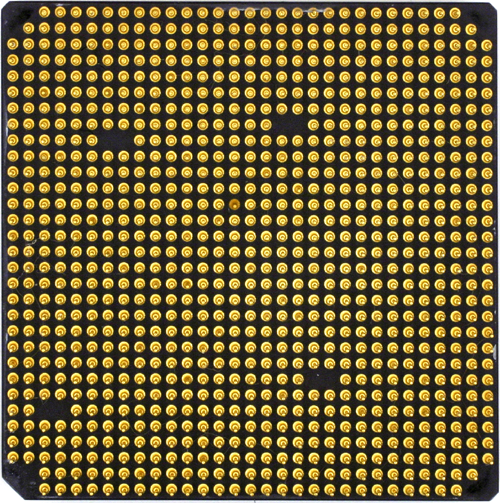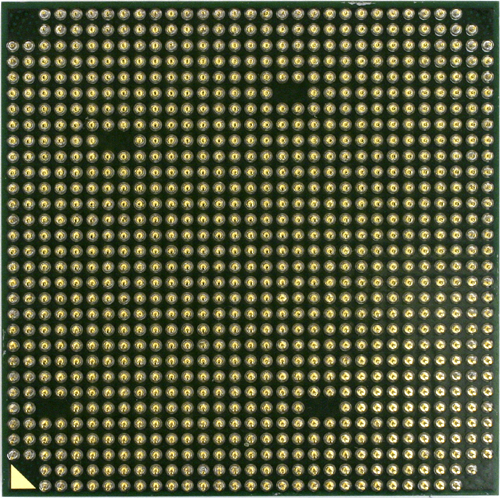AMD Athlon 64 3800+ and FX-53: The First 939 CPUs
by Derek Wilson on June 1, 2004 12:30 AM EST- Posted in
- CPUs
The Chips
Launching on the socket 939 platform today are the Athlon 64 3500+, 3800+ and FX-53 CPUs. As we have mentioned in previous news articles, these new CPUs include the 3500+, 3800+ and FX-53. The 3500+ will run at 2.2GHz while the 3800+ and FX-53 will run at 2.4GHz each. Here's a comparison shot of a 940 pinout and a 939 pinout:

This is a socket 940 processor

This is a socket 939 processor
Aside from the difference in packaging, the only new thing about these processors is their on die memory controller. These parts are the first to be equipped with a memory controller that can handle dual channel unbuffered DDR memory. As we have seen, integrating a memory controller on die has been a successful way of maintaining performance for AMD, but the drawback is when AMD wants to make its processors work with a new type of memory: they need to redesign part of the silicon.
Here's a table that lays out the processors and their specifications adopted from one of our earlier roadmap articles:
| Current AMD Athlon 64 and FX processors | ||||
|---|---|---|---|---|
| Clock Speed | Cache Size | Dual Channel | Unbuffered | |
| Athlon 64 FX-55 (939) | 2.6GHz |
1MB |
Yes |
Yes |
| Athlon 64 FX-53 (939) | 2.4GHz |
1MB |
Yes |
Yes |
| Athlon 64 FX-53 (940) | 2.4GHz |
1MB |
Yes |
No |
| Athlon 64 3800+ (939) | 2.4GHz |
512KB |
Yes |
Yes |
| 3700+ (754) ??? | 2.4GHz |
1MB |
No |
Yes |
| Athlon 64 3500+ (939) | 2.2GHz |
512KB |
Yes |
Yes |
| Athlon 64 3400+ (754) | 2.2GHz |
1MB |
No |
Yes |
The questions are next to the 754 pin 3700+ part because we haven't seen one yet, and we didn't run any numbers for that particular configuration.
The 939 pin Athlon 64 parts we know about have 512kB L2 caches, this means that he 3500+ actually has less cache than the equivalently clocked 3400+ 754 pin CPU (the same is true when comparing the 3700+ 1MB part to the 3800+). If we are to expect performance to match the rating system, this means that AMD expects the addition of a dual channel memory controller to more than make up for a halving of the cache.
The slight name change in equivalently clocked parts has had us wondering for a while if we would see the expected increase in performance. With an increase in rating of 100 points for the 3400+ and 3700+, we would expect to maximally see 2.9% and 2.7% increases in performance. Anything around the 2% mark will be enough for us to be comfortable with the new naming scheme, but we certainly don't want to see too many lower numbers.
Normally in testing, we consider a less than 3% margin to be essentially equivalent performance, but this time around we will be paying a little closer attention to any small increases in performance in order to determine whether or not this new performance rating is deserved.
The new FX-53 part number has obviously not changed, as its model number is dependant upon clock speed. We will also not be seeing as significant a performance increase from 940 to 939 pin platforms as upgrading to dual channel from single channel will have a higher impact on performance than moving from registered to unbuffered memory. On the 939 platform, the only performance factor that separates the FX series from the rest of the Athlon 64 line will be its 1MB L2 cache size. Of course, to help maintain its status as an enthusiast part, the FX series will also be completely multiplier unlocked.
But there is a caveat to that as well. With the advent of AMD's Cool'n'Quiet (which is similar in affect to Intel's Enhanced SpeedStep), motherboard makers who choose to implement the technology will be able to offer their users downwardly unlocked multipliers for the Athlon 64 platform. Being able to decrease the multiplier is very important for hardcore overclockers as much higher bus speeds (and thus RAM speeds) are attainable when the core multiplier can be lowered.










38 Comments
View All Comments
Icewind - Tuesday, June 1, 2004 - link
Slight gramatical problem here......As we have mentioned in previous news articles, these new CPUs will run at the 3500+ will run at 2.2GHz while the 3800+ and FX-53 will run at 2.4 GHz each.
I think you wanted to say "These new CPU"S will be starting at the 3500+ model running at 2.2ghz to the 3800+ running at 2.4ghz."
Viditor - Tuesday, June 1, 2004 - link
"I have updated the article to reflect the fact that we did indeed run our tests with 1T timings on the MSI K8T800 Pro 939 board"Thanks Derek...that's why I always read you guys!
WBurton - Tuesday, June 1, 2004 - link
I'm getting a bit frustrated with the Sponsored Links constantly crashing my Opera 7.x. It'd be nice to review an article without having to reboot all the time.MIDIman - Tuesday, June 1, 2004 - link
Is it possible that the release of a 64-bit OS will change all of these numbers and conlcusions?Lonyo - Tuesday, June 1, 2004 - link
1066MHz HT bus?I thought the HT bus ram 200xmult
So isn't it 200x5, or 1000MHz?
(Typo on the first page?)
boban10 - Tuesday, June 1, 2004 - link
what i dont like about many review sites that they encoding always the same codec and then say p4 is faster.well look here how they test it:
http://www.extremetech.com/article2/0,1558,1603531...
i hope that your and anandtech next reviews will be more in depth about encoding, cause if people read your reviews about encoding they will buy p4.
but p4 is not faster in all encoding and that is important to say and test. and i like this site, but if next time i see again only one test in encoding (and that where is know that p4 win) then i will not read your page anymore. and no im not amd fan, im performance fan.
mechBgon - Tuesday, June 1, 2004 - link
Jeff7181, you asked "Is running four unbuffered DIMMs really that necessary?"I was running three 512MB modules on my A7N8X Deluxe before replacing it with my K8V Deluxe. That was working out nicely for what I was using it for. When I installed my A64 and K8V Deluxe, I stepped *down* to 1.0GB because if I used all three modules, it would want to run them at DDR200/PC1600 speeds. If I could add a fourth module for 2.0GB total, that would be a welcome improvement. Yeah, I could invest in two 1GB DIMMs, I guess...
Intel's i865 and i875 families have brought 4 DDR400 DIMMs to Pentium4 owners, and that capability, along with CSA Gigabit, are two places where I have to admit Intel trumped AMD & Co. nicely, and has kept them trumped for quite a while too. So it would be nice to see AMD get their mojo working here.
DerekWilson - Tuesday, June 1, 2004 - link
I have updated the article to reflect the fact that we did indeed run our tests with 1T timings on the MSI K8T800 Pro 939 board.I appologize for the omission.
Viditor - Tuesday, June 1, 2004 - link
I wonder if Derek caught the bios setting tweak that Aces found."An incredible difference: with a faster bus turnaround, the memory subsystem is able to serve up to 24% more bandwidth, and the latency goes down from 51 (21.25 ns) to 47 cycles (19.6 ns). This results in measurable real world performance gains:
In 3DS Max 5.1, we gained 3% of performance
In Medieval War, Comanche we also gained 3%
In Wolfenstein: Enemy Territory, we gained 5.5%
In WinRAR and Plasma, the performance advantage was no less than 9%"
http://www.aceshardware.com/read.jsp?id=65000305
nycxandy - Tuesday, June 1, 2004 - link
Which motherboard was used for the 939 processors?